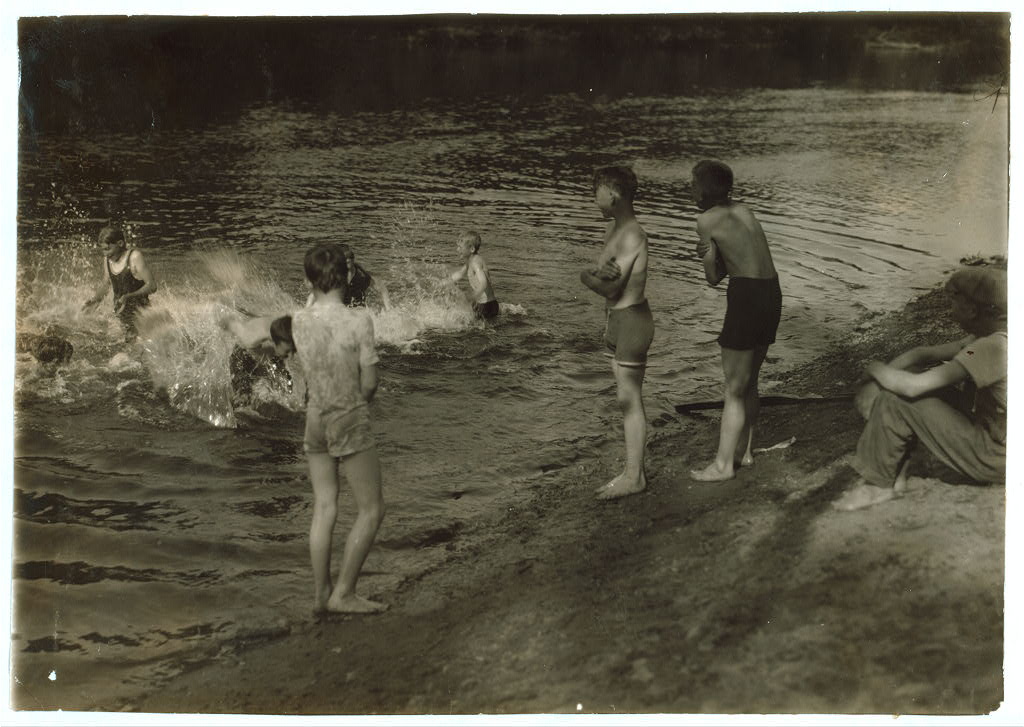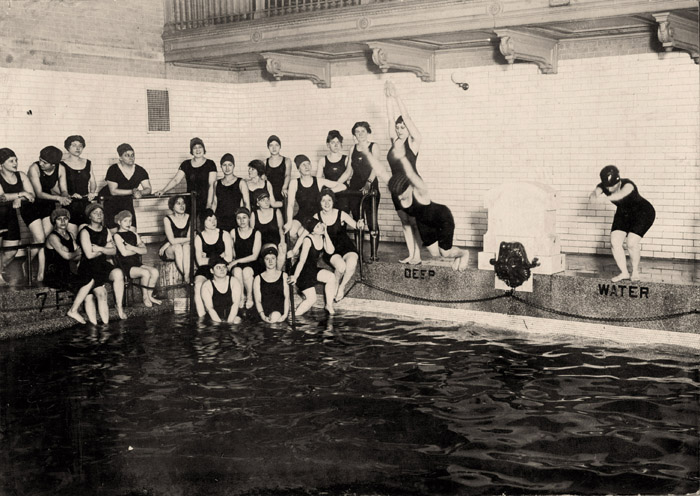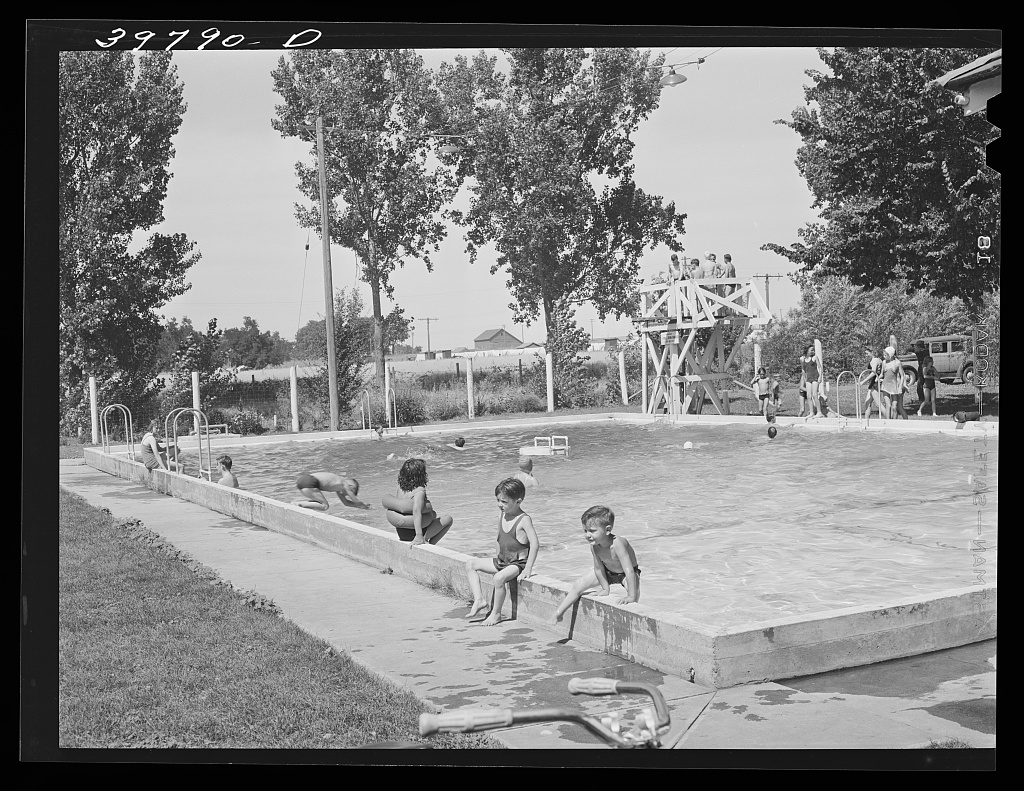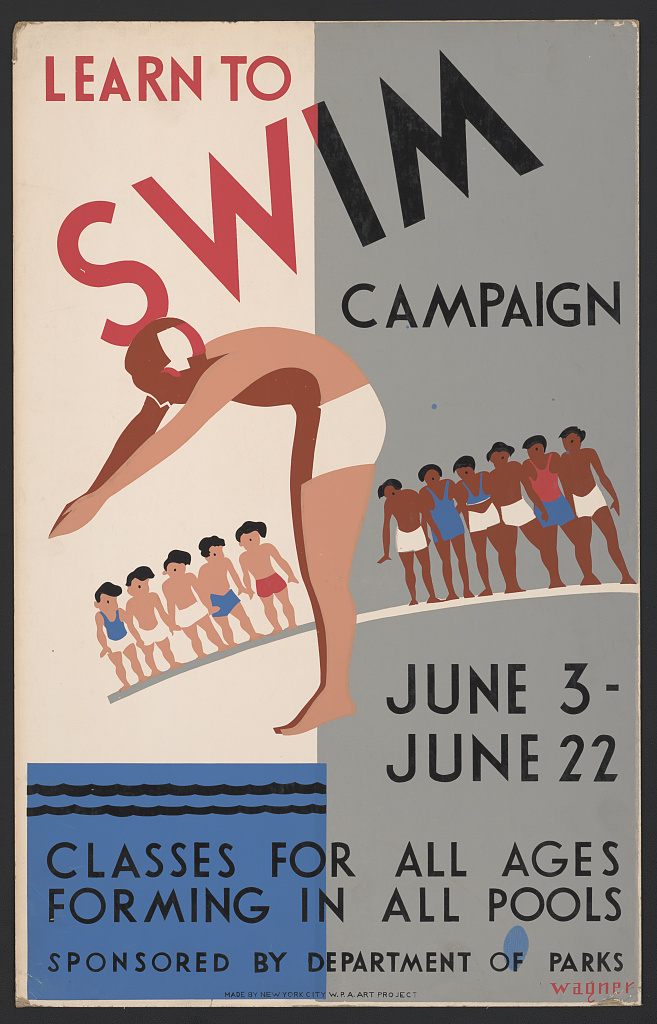Data and Analysis |Literature Review: Swimming by Space | Introduction | Swimming through Childhood- Katrina Tracy | Swimming through Childhood Conclusion
While swimming ended up as a middle class leisure activity as well as a school activity, it had started out as a utilitarian construct. Starting in the 1800s until the invention of filtered swimming pools in the early 1900s it was common for bathhouses to be the place where people of all genders and ages went to get clean. Children have interacted with swimming in various ways throughout different spaces throughout time.
Natural Areas

Lewis Hine 1916
Before the public bath houses and municipal swimming pools, swimming culture was established among young men in lakes, rivers and other outside swimming areas. Natural swimming was done often in the nude, therefore was a primarily a male youth activity. In fact long battles were fought by cities of Milwaukee and New York City against male youths who were uncouthly roughhousing. Wiltse asserts that swimming outside was an integral part of male adolescents with “some boys” reportedly fighting back an anti-swimming law by saying they might as well “don frocks”. It is clear that children were forming their ideas of masculinity and gender roles though the venue of swimming. Swimming outside was a decidedly young man activity, as well as plebeian and working class. (Wiltse 2007, p. 10-13)
Girls did not swim outside. It was seen as immodest to be nude, however the one exception is the competitive swimming races that happened outdoors. Here both female and male swimmers attracted huge crowds to natural swimming races, where of course both sexes were clothed (Zanoni 2005).

Female swimmers practice at the East 23rd public bath in New York City. Courtesy of the New York City Department of Parks and Recreation
Bathhouses
Public baths were a Victorian era reform that preceded the municipal pool heyday. Built by reformers to “promote cleanliness, modesty and refinement among the urban poor” (Wiltse 2007, p. 9) A “public bath” type situation (Wiltse 1007, p. 2), where it was essential for the urban unwashed masses to have somewhere to was off and there was no filtration system of the water. Pools were used for bathing and focus was on the cleanliness of the individual as opposed to the later swimming pools that had a larger focus on swimming as an athletic exercise, where swimmers were expected to be clean before they entered the pool. (Gutman 2009, p. 539). Bathhouses were not segregated as they were seen to be for all of the poor and so Black people were included in that. Later, when pools were built for pleasure that is when Black children started getting excluded from swimming as an activity. Notable that Black children were not necessarily excluded from swimming as a means to get clean (Wiltse 2007, p. 1).
Swimming Pools

Children at a swimming pool set up for agricultural worker’s families Lee Russel https://lccn.loc.gov/2017790050 1941
As swimming became a middle class activity and pools were able to have filtration systems, there was a large rise in swimming as a physical activity and an athletic ideal. Schools ran swimming classes for boys and girls. Teachers had extensive curriculum and strategies to teach various strokes and dives. Young people participated in swim meets. YMCAs, lead by George Corsan pioneered teaching techniques young people to swim (YMCA). In addition public schools started having many swimming classes, as well as mass federal learn to swim campaigns. This was all brought about by the creation of the swimming pool in a way the bathhouses had not been utilized. In the 1930s thousands of public pools were created for the express purpose of swimming. (Gutman 2009, p. 535). The idea that children needed to go to school or engage in play rather than work created a need for appropriate activities, such as swimming. Swimming was viewed as healthy physical activity, and it was popular with girls and boys.
However, not everyone was allowed to go swimming. Segregation was codified into swimming pool usage and swimming pools were not often built in Black neighborhoods (Gutman 2009, p. 538). As anecdotally referenced by P. Austen, black children were able to enjoy swimming only in dangerous areas such as channels by the wharf (where children had already drowned), in the Lincoln Memorial Reflecting pool and in the City’s only Black pool (as opposed to one of the nine white pools). (Austen 2019). Black children were not included via segregation in the swimming craze, but still found ways to enjoy the water.

Learn to swim campaign Classes for all ages forming in all pools / / Wagner.
In addition to the racialization of the swimming pool as a playspace, there was also conflicting gender ideology. Girls were not always encouraged to swim. Though there was vast participation in swimming as a school and recreation activity by girls it was compounded by ideas of modesty (swimwear) and boys were definitely encouraged more. Many female gym teachers argued for larger inclusion of women in sports despite biological differences and possible handicaps for girl participation. However there were many famous competitive swimmers that were closely followed by the general populace, with thousands showing up to spectate and support their favorite female swimmers. (Zanoni 2005, p. 15) In fact, girls were encouraged to swim indoors, (as opposed to the immodest outdoor swimming) and wear special bathing suits. (Zemlock 1937, p. 49-50)
Though there was overall less programming for girls, “Swimming as a competitive sport for women became of national interest as evidenced by the widespread participation of female swimmers from all parts of the country during the 1920s and 1930s.” (Zanoni 15). As shown in the “Learn to Swim” poster, there are more boys pictured than girls, and though there are people of color represented they are obviously segregated. The poster obviously shows the social conditions and stratifications of the time, even within the realm of children’s swimming. The literature shows how interactions between the physical geography of the pool and swim space allowed for different interactions between different genders of children.